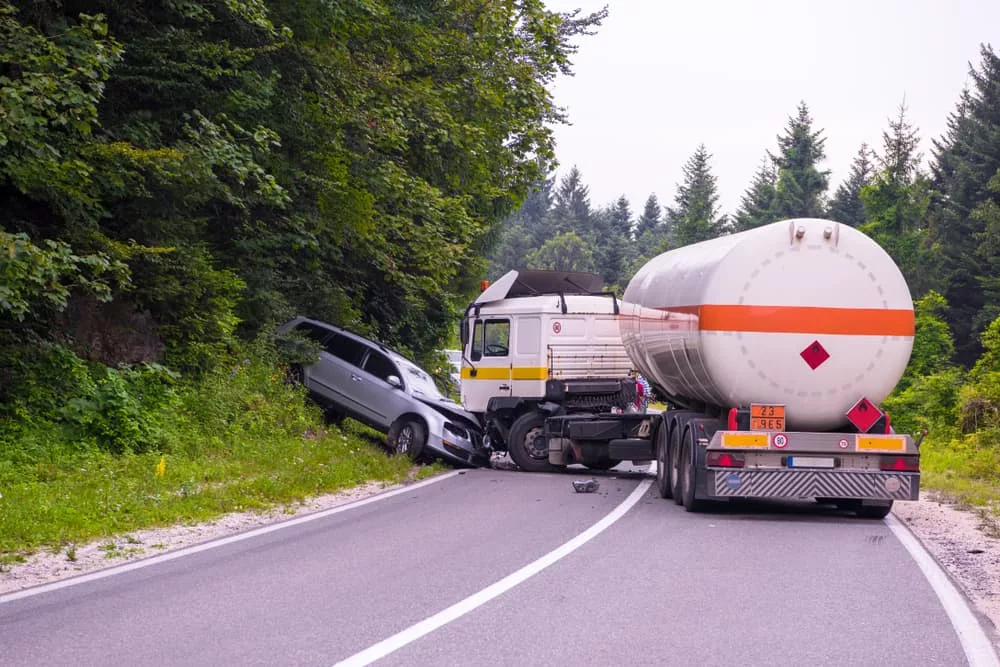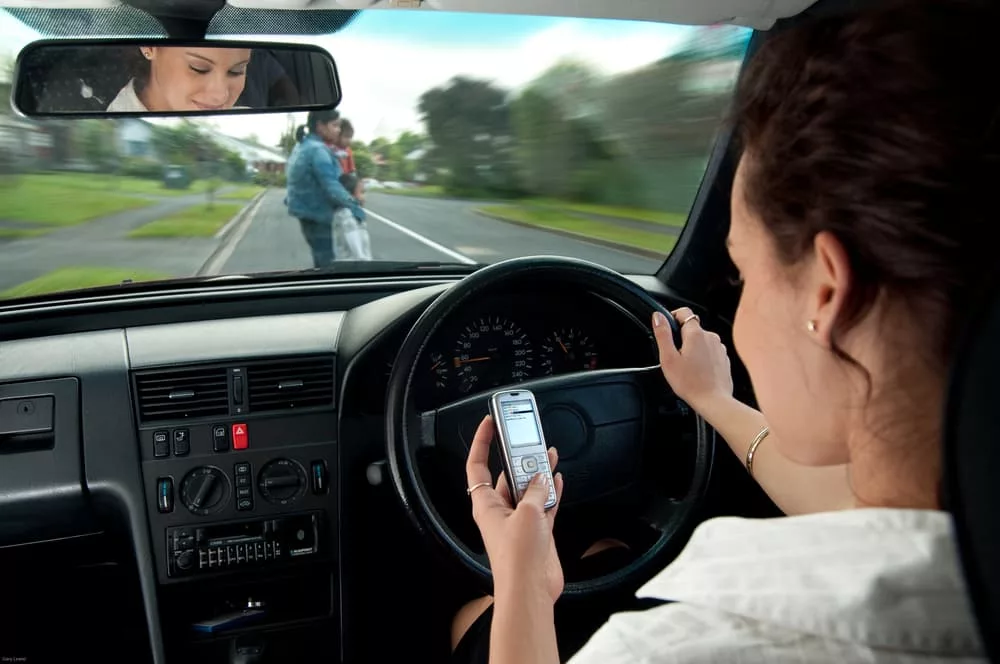Distracted driving is one of the most common causes of traffic accidents in the U.S., resulting in thousands of deaths and hundreds of thousands of injuries each year. While many people associate distracted driving with cell phone use (and rightfully so), many other driver distractions can cause accidents.
If you’ve been injured in a distracted driving accident, get legal help. A personal injury attorney can protect your rights and assist you in seeking compensation.
Here is a look at what distracted driving is, including the most common forms of distraction that drivers should avoid.
What Is Distracted Driving?
According to the Centers for Disease Control and Prevention (CDC), distracted driving is a major cause of injury and death on U.S. roads, with more than 3,100 people killed and around 424,000 injured each year as a result of accidents caused by distracted drivers.

The three types of driver distractions include:
- Visual distractions that cause a driver to look away from the road
- Manual distractions that cause a driver to take their hands out of the proper position on the steering wheel
- Cognitive distractions that cause a driver to think about other things besides driving safely
Drivers who operate vehicles on public roadways are required to take reasonable actions to avoid causing harm to others.
When a driver is distracted visually, they can miss important pieces of information that would lead them to take these reasonable actions, such as an upcoming traffic light turning red and requiring them to stop and yield the right-of-way to the users of other travel lanes or a pedestrian stepping into the roadway in their path that would cause them to brake or swerve to avoid hitting the pedestrian.
A manually distracted driver lacks the control over their vehicle needed to maintain a single travel lane or swerve to avoid an accident. If their mind drifts to other things, they can make hazardous errors such as not yielding when required, not monitoring their speed, and not noticing the actions and intentions of other drivers.
What Driving Distractions Can Lead to Accidents?
Any activity a driver does while operating their vehicle can become a distraction if it draws the driver’s focus and attention away from the safe operation of their vehicle. Here is a look at some of the most common driving distractions that can lead to accidents.
Texting and Other Cell Phone Use
Of all distractions, texting and other types of cell phone use, such as checking email, talking on the phone, taking selfies, or browsing social media, are among the most dangerous. They simultaneously cause a driver to take their hands from the proper position on the steering wheel to input numbers or information into their phone, take their eyes from the roadway, and their minds off the task of safe driving.
As the organization End Distracted Driving explains, it takes about five seconds to read or reply to a text message. While that seems like a short period, a vehicle traveling at 55 mph will travel the length of a football field without its driver attending to the road.
Distracted driving affects a driver’s ability to safely operate a motor vehicle, similar to driving at the legal alcohol impairment limit of 0.08 grams of alcohol per deciliter of blood.
Compared to undistracted drivers, those using their cell phones while driving are 9 percent slower to brake when needed. They showed a 24 percent higher variance in the distance at which they followed other vehicles as their attention switched from conversing on the phone and focusing on driving.
Drivers using cell phones resumed average speed 19 percent slower after braking and were more than five times more likely to get into an accident.
End Distracted Driving also notes that while over 84 percent of drivers recognize the dangers associated with cell phone use while driving, 36 percent admit to having sent a text or email through their cell phones while behind the wheel within the past month. The issue is particularly concerning with teen drivers, who are more prone to driving distractions and more likely to cause accidents due to their lack of driving experience.
The prevalence of texting drivers and an associated increase in traffic accidents have prompted nearly every state in the nation to adopt some form of texting and driving law, with some states only restricting the activity among young drivers and other states banning cellphone use while driving in certain areas, and others to prohibit the use of any handheld device while driving.
Eating, Drinking, or Smoking
While texting is one of the most talked-about types of driver distractions, it is far from the only activity that can prevent a driver from properly attending the roadway. Another common type of driver distraction is eating, drinking, or smoking, which is particularly common not only for drivers traveling long distances in a short time frame but also commuters who are multi-tasking by eating or having coffee on their way to work.
These activities distract drivers:
- Looking away from the road and reaching into a bag or container for food, which draws the driver’s spatial awareness away from the road and can lead to mishaps such as bumping the steering wheel or gear shifter.
- Spilling food, which causes an instinctual physical reaction that can result in the loss of control of the vehicle or cause the driver to look away from the road to attend to the spill.
- Smoking in the vehicle not only causes a driver to look away and take a hand from the wheel to light and hold the cigarette but can also create smoke clouds inside the vehicle that can impair the driver’s ability to see or can even irritate their eyes and cause them to close their eyes while driving. The burning tip of the cigarette can lead to additional dangerous distractions, such as looking away from the road to retrieve a lit cigarette that has been dropped or even causing a fire inside the vehicle.
Adjusting Vehicle Controls or GPS
The stereo. The heater or air conditioner. The windows and the windshield wipers. Each of these features is commonly found in motor vehicles, and adjusting them while driving causes the driver to look away from the road and take a hand from the wheel to push a button or turn a lever. The precious few seconds involved in these activities can result in severe or even tragic accidents.
Vehicle GPS navigation systems are another major cause of distracted driving.
As explained by iDriveSafely, GPS systems present four distracted driving risks:
- Programming the GPS while driving, which is similar in effect to texting while driving as the driver is simultaneously focusing on their GPS, looking as they input information into the device, and using one hand to input that information.
- Muting the GPS to listen to music, which means that the driver must look away from the road to follow the device’s directions.
- Looking up directions to a retail store, restaurant, or residence while driving. According to the results of an iDriveSafely survey, over half of all drivers have looked up directions while operating their vehicles.
- Reacting slowly to the GPS’s directions. When a GPS is slow in delivering instructions or a driver misinterprets those instructions, the driver can become frustrated and commit dangerous driving actions such as making sudden turns or lane changes.
Visiting With Other Occupants of the Vehicle

Having a passenger in the car can make a road trip less boring and help a driver stay awake. Unfortunately, additional passengers—including children or pets in the back seat—can create driver distractions that not only involve looking away from the road but also allow one’s attention to stray from the task of safe driving.
According to the National Highway Traffic Safety Administration (NHTSA), teen drivers’ passenger distraction risk is exceptionally high. A loud conversation in a car full of teens makes the young driver five times more likely to get into an accident, and horseplay increases their risk by 9 percent.
The risks posed to teen drivers by passenger distractions have led several states to enact graduated driver’s licensing laws that prohibit new drivers from carrying other passengers besides their parents or siblings in their car for several months after obtaining their license.
External Distractions
Internal distractions such as GPS, cell phones, food, or even other passengers are common causes of distracted driving accidents. However, driver distractions can occur outside of the vehicle as well.
External distractions that can lead to accidents include:
- Other people or cars on the road. There is a tie between distracted driving and road rage that occurs when a driver becomes angry or annoyed at the driving behavior of another roadway user. This anger can become a cognitive distraction, leading them to commit aggressive driving practices to get past the offending driver or to focus on punishing the driver for a perceived slight while ignoring other things occurring on the roadway.
- The scenes of previous accidents or law enforcement activity occurring on the road. Rubbernecking refers to a driver taking their eyes from watching the road to look at a distraction such as an accident or arrest. Commonly, the driver has not only stopped looking at the road but has also slowed down to satisfy their curiosity, disrupting the flow of traffic in the process.
The Types of Accidents Caused by Distracted Driving
Distracted driving can cause nearly any accident on a public road, including:
- Rear-end collisions. These accidents involve the front of one vehicle colliding with the back of another. Looking away from the road can cause a driver to miss certain clues about the intentions of the driver of the vehicle in front of them, such as brake lights indicating that the driver is slowing down or stopping.
- Head-on collisions. Head-ons are a particularly deadly type of accident that occurs when the front of one vehicle collides with the front of another. A driving distraction can lead to a head-on when a driver drifts into an opposing lane of travel or turns the wrong way down a one-way road or freeway entrance while not paying attention to their driving.
- Broadside (T-bone) accidents. These accidents are one of the most common types of accidents to occur in intersections and are generally the result of one driver failing to yield the right-of-way to drivers in other directional travel lanes. Distraction can cause a driver to fail to realize the light has changed and enter the intersection when they do not have the right-of-way.
- Sideswipes. This type of accident involves the side of one vehicle colliding or contacting the other vehicle and can occur when a distracted driver meanders into an occupied adjacent travel lane.
- Rollovers. A rollover accident involves the vehicle turning over onto its side, roof, or completely rolling over and is commonly caused by the vehicle’s tires tripping over an obstacle in or around the road, such as a median. When drivers are not paying attention to the roadway and do not have their hands properly positioned on the steering wheel, they have less control over where their vehicle is going and the ability to avoid an accident.
- Accidents involving vulnerable road users such as pedestrians or bicyclists. Drivers owe vulnerable road users an increased duty of care as they are more likely to sustain serious harm in a collision. Drivers are required to take reasonable actions to avoid injuring bicyclists and pedestrians, even if the driver has the right-of-way. It is a lot harder to take these actions when distractions prevent the driver from noticing the pedestrian or bicyclist near the road.
Related articles
Related articles Related articles Related articles Related articles Related articles Related articles Related articles Related articles Related articles Related articles
Personal Injury
02 Feb 2024
How Long After An Accident Can You Claim Injury?





